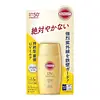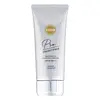What's inside
What's inside
 Key Ingredients
Key Ingredients

 Benefits
Benefits

 Concerns
Concerns

 Ingredients Side-by-side
Ingredients Side-by-side

Water
Skin ConditioningCyclopentasiloxane
EmollientZinc Oxide
Cosmetic ColorantAlcohol Denat.
AntimicrobialEthylhexyl Methoxycinnamate
UV AbsorberIsododecane
EmollientCaprylic Acid
CleansingC12-15 Alkyl Benzoate
AntimicrobialSilica
AbrasiveTrimethylsiloxysilicate
EmollientDiethylhexyl Succinate
EmollientDiethylamino Hydroxybenzoyl Hexyl Benzoate
UV FilterPolysilicone-15
UV FilterBis-Ethylhexyloxyphenol Methoxyphenyl Triazine
Skin ConditioningChamomilla Recutita Flower Extract
MaskingSalvia Officinalis Leaf Extract
CleansingTocopherol
AntioxidantSodium Hyaluronate
HumectantSimmondsia Chinensis Seed Oil
EmollientHydrolyzed Collagen
EmollientButylene Glycol
HumectantBHT
AntioxidantAcrylates/Ethylhexyl Acrylate/Dimethicone Methacrylate Copolymer
Skin ConditioningStearoyl Inulin
EmollientTriethoxycaprylylsilane
Polyhydroxystearic Acid
EmulsifyingLauryl PEG-9 Polydimethylsiloxyethyl Dimethicone
Skin ConditioningSodium Lauroyl Glutamate
Phenoxyethanol
PreservativeWater, Cyclopentasiloxane, Zinc Oxide, Alcohol Denat., Ethylhexyl Methoxycinnamate, Isododecane, Caprylic Acid, C12-15 Alkyl Benzoate, Silica, Trimethylsiloxysilicate, Diethylhexyl Succinate, Diethylamino Hydroxybenzoyl Hexyl Benzoate, Polysilicone-15, Bis-Ethylhexyloxyphenol Methoxyphenyl Triazine, Chamomilla Recutita Flower Extract, Salvia Officinalis Leaf Extract, Tocopherol, Sodium Hyaluronate, Simmondsia Chinensis Seed Oil, Hydrolyzed Collagen, Butylene Glycol, BHT, Acrylates/Ethylhexyl Acrylate/Dimethicone Methacrylate Copolymer, Stearoyl Inulin, Triethoxycaprylylsilane, Polyhydroxystearic Acid, Lauryl PEG-9 Polydimethylsiloxyethyl Dimethicone, Sodium Lauroyl Glutamate, Phenoxyethanol
Tranexamic Acid
AstringentTocopheryl Acetate
AntioxidantWater
Skin ConditioningZinc Oxide
Cosmetic ColorantDipropylene Glycol
HumectantEthyl Polysilicate
Alcohol Denat.
AntimicrobialPropylene Glycol Dicaprate
EmollientPropylene Glycol Dicaproate
EmollientPolydiethylsiloxane
EmollientBis-Ethylhexyloxyphenol Methoxyphenyl Triazine
Skin Conditioning4-Hydroxybenzoic Acid
PreservativeHydrogenated Castor Oil
EmollientMethyl/Phenyl Polysilsesquioxane
Glycerin
HumectantPhthalic Anhydride
Sodium Stearic Acid Sulfate
EmulsifyingEel Extract
HumectantOrange Roughy Oil
Skin ConditioningChamomilla Vulgaris Extract
Skin ProtectingShilajit Extract
Sus Extract
Skin ConditioningTuna Extract
Skin ConditioningSodium Hyaluronate
HumectantHumulus Lupulus Extract
AntimicrobialWine Extract
AntioxidantYogurt Extract
Skin ConditioningCoix Lacryma-Jobi Ma-Yuen Seed Extract
Skin ConditioningCitrus Limon Fruit Extract
MaskingRosmarinus Officinalis Leaf Extract
AntimicrobialChamomilla Recutita Extract
Skin ConditioningButylene Glycol
HumectantIsohexadecane
EmollientIsopropyl Titanium Triisostearate
EmollientXanthan Gum
EmulsifyingSorbitan Fatty Acid Ester
EmulsifyingDi-T-Butylhydroquinone
AntioxidantCetearyl Alcohol
EmollientSodium Metabisulfite
AntioxidantBehenyl Alcohol
EmollientSteardimonium Ethyl Stearyl Phosphate
Skin ConditioningPhosphoric Acid
BufferingEthylhexyl Polyhydroxystearate
EmollientSorbitan Oleate
EmulsifyingAlcohol
AntimicrobialPhenoxyethanol
PreservativeTranexamic Acid, Tocopheryl Acetate, Water, Zinc Oxide, Dipropylene Glycol, Ethyl Polysilicate, Alcohol Denat., Propylene Glycol Dicaprate, Propylene Glycol Dicaproate, Polydiethylsiloxane, Bis-Ethylhexyloxyphenol Methoxyphenyl Triazine, 4-Hydroxybenzoic Acid, Hydrogenated Castor Oil, Methyl/Phenyl Polysilsesquioxane, Glycerin, Phthalic Anhydride, Sodium Stearic Acid Sulfate, Eel Extract, Orange Roughy Oil, Chamomilla Vulgaris Extract, Shilajit Extract, Sus Extract, Tuna Extract, Sodium Hyaluronate, Humulus Lupulus Extract, Wine Extract, Yogurt Extract, Coix Lacryma-Jobi Ma-Yuen Seed Extract, Citrus Limon Fruit Extract, Rosmarinus Officinalis Leaf Extract, Chamomilla Recutita Extract, Butylene Glycol, Isohexadecane, Isopropyl Titanium Triisostearate, Xanthan Gum, Sorbitan Fatty Acid Ester, Di-T-Butylhydroquinone, Cetearyl Alcohol, Sodium Metabisulfite, Behenyl Alcohol, Steardimonium Ethyl Stearyl Phosphate, Phosphoric Acid, Ethylhexyl Polyhydroxystearate, Sorbitan Oleate, Alcohol, Phenoxyethanol
 Reviews
Reviews

Ingredients Explained
These ingredients are found in both products.
Ingredients higher up in an ingredient list are typically present in a larger amount.
Alcohol Denat. is an alcohol with a denaturant property. It is created by mixing ethanol with other additives.
This ingredient gets a bad rep because it is irritating and drying - mostly due to its astringent property. Astringents draw out natural oils in tissue, constricting pores and leaving your skin dried out.
However, alcohol denat. is not all that bad.
Due to its low molecular weight, alcohol denat. tends to evaporate quickly. One study on pig skin found half of applied alcohol evaporated in 10 seconds and less than 3% stayed on skin.
This also helps other ingredients become better absorbed upon application.
Studies are conflicted about whether this ingredient causes skin dehydration. One study from 2005 found adding emollients to propanol-based sanitizer decreased skin dryness and irritation. Another study found irritation only occurs if your skin is already damaged.
Small amounts of alcohol are generally tolerated by oily skin or people who live in humid environments.
The rule of thumb is if this alcohol is near the end of an ingredients list, it will probably not affect your skin much.
Also...
This ingredient has antimicrobial and solvent properties.
The antimicrobial property helps preserve products and increase their shelf life. As a solvent, it helps dissolve other ingredients.
Other types of astringent alcohols include:
Learn more about Alcohol Denat.You might know this ingredient as Tinosorb S or Bemotrizinol. It is a UV filter that covers both UVA and UVB rays.
This ingredient has two peak UV absorption peaks ( 310 and 340 nm) and is able to absorb both UV-A and UV-B rays. This ingredient works by preventing UV rays from reaching and damaging your skin.
On top of that - it is highly photostable and helps prevent the photodegration of other sunscreen ingredients such as avobenzone.
Tinosorb S is allowed in the EU, Australia, and Asia. It is close to being approved by the FDA and we'll hopefully get this ingredient in the U.S. by late 2025.
Fun fact: Tinosorb S is the most effective UV absorber at maximum concentration (measured by SPF) permitted in the EU.
This ingredient is oil-soluble, so your oil-cleansers will take this right off at night.
Learn more about Bis-Ethylhexyloxyphenol Methoxyphenyl TriazineButylene Glycol (or BG) is used within cosmetic products for a few different reasons:
Overall, Butylene Glycol is a safe and well-rounded ingredient that works well with other ingredients.
Though this ingredient works well with most skin types, some people with sensitive skin may experience a reaction such as allergic rashes, closed comedones, or itchiness.
Learn more about Butylene GlycolPhenoxyethanol is a preservative that has germicide, antimicrobial, and aromatic properties. Studies show that phenoxyethanol can prevent microbial growth. By itself, it has a scent that is similar to that of a rose.
It's often used in formulations along with Caprylyl Glycol to preserve the shelf life of products.
Sodium Hyaluronate is hyaluronic acid's salt form. It is commonly derived from the sodium salt of hyaluronic acid.
Like hyaluronic acid, it is great at holding water and acts as a humectant. This makes it a great skin hydrating ingredient.
Sodium Hyaluronate is naturally occurring in our bodies and is mostly found in eye fluid and joints.
These are some other common types of Hyaluronic Acid:
Learn more about Sodium HyaluronateWater. It's the most common cosmetic ingredient of all. You'll usually see it at the top of ingredient lists, meaning that it makes up the largest part of the product.
So why is it so popular? Water most often acts as a solvent - this means that it helps dissolve other ingredients into the formulation.
You'll also recognize water as that liquid we all need to stay alive. If you see this, drink a glass of water. Stay hydrated!
Learn more about WaterZinc Oxide is a mineral broad-spectrum UV filter; it is the broadest UVA and UVB reflector approved by the FDA. It also has skin protectant and skin soothing properties.
Zinc oxide is one of the most effective broad-spectrum UV filters. It protects against UVB, UVAII, and UVAI. In comparison to its counterpart titanium dioxide, zinc oxide provides uniform and extended UVA protection.
Another great benefit? This ingredient is highly photostable so it won't degrade easily under sunlight.
A common myth is that mineral UV filters are widely believed to primarily reflect UV light.
However, modern research shows titanium dioxide absorbs UV radiation like chemical filters (~95% absorption & 5% reflection).
Zinc oxide has great skin soothing properties so you'll likely find this in sunscreens formulated for sensitive skin or babies/children. It is unlikely to cause "eye sting" like other sunscreen ingredients.
Regulatory agencies consider zinc oxide to be non-toxic and safe. It has also been shown to not penetrate the skin.
Unfortunately, this ingredient does leave a visible white cast. This is why mineral sunscreens are often less cosmetically elegant than chemical or hybrid ones.
In cosmetics, zinc oxide can be found in both non-nano and nano-sized forms. The nano version is used to reduce white cast and improve the texture of sunscreen formulas.
There are ongoing concerns surrounding nano-zinc oxide's impact on marine ecosystems and whether it can be absorbed into skin.
Regarding marine ecosystems and coral reefs, there is no conclusive evidence that any form of zinc oxide (or any other sunscreen ingredients) will cause harm. The science is still developing but many consumers are keeping a close eye on this issue.
Please note, many destinations have reef-safety sunscreen rules. For instance, the U.S. Virgin Islands advises all visitors to use non-nano mineral sunscreens.
There has also been some stir about whether micronized or nano zinc oxide has potential photoxicity and absorption through the skin/lungs.
An in-vitro (done in a test tube or petri dish) study demonstrated micronized zinc oxide to have potential phototoxicity. There's no need to fret; the EU Commission's Scientific Committee on Consumer Safety has stated, "The relevance of these findings needs to be clarified by appropriate investigations in vivo." Or in other words, further studies done on living organisms are needed to prove this.
Current research shows zinc oxide nanoparticles do not penetrate intact or sunburned skin. They either remain on the surface or in the outermost layer of dead skin (stratum corneum).
Zinc oxide is one of only two classified mineral UV filters with titanium dioxide being the other one.
Fun fact: Zinc has been used throughout history as an ingredient in paint and medicine. An Indian text from 500BC is believed to list zinc oxide as a salve for open wound. The Ancient Greek physician Dioscorides has also mentioned the use of zinc as an ointment in 1AD.
Learn more about Zinc Oxide